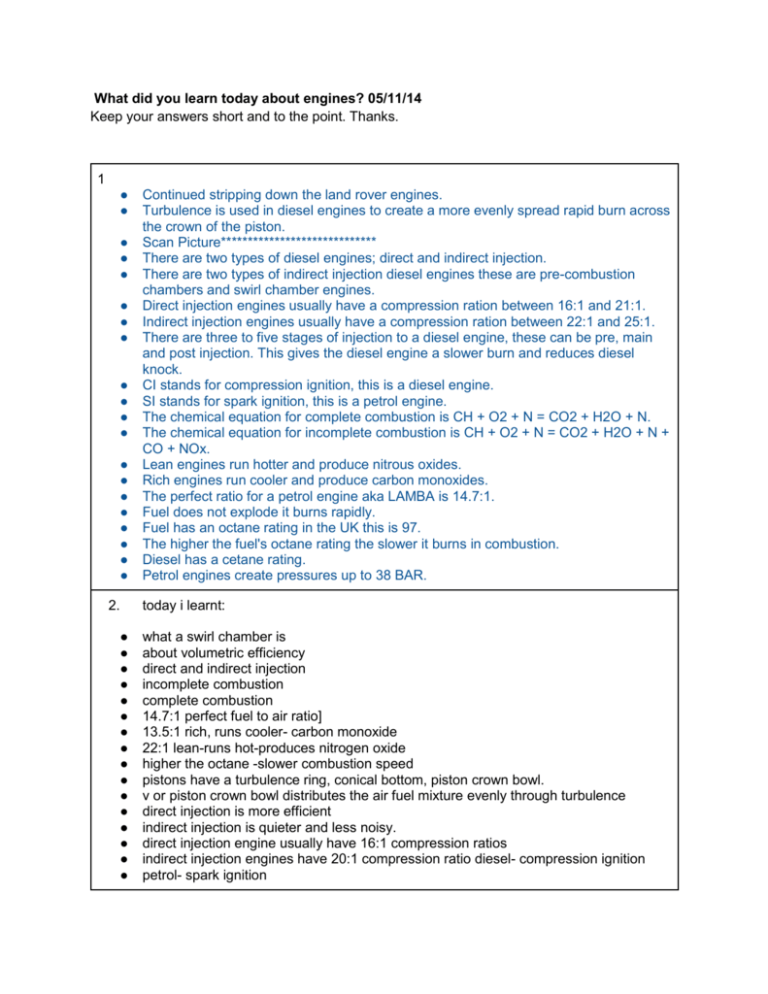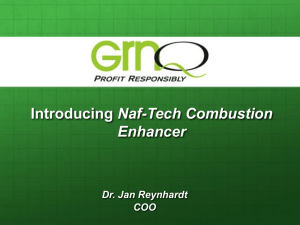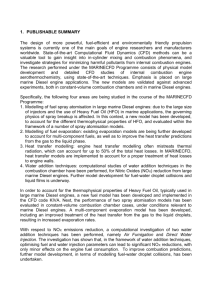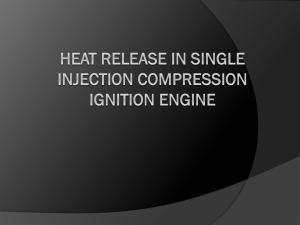File
advertisement

What did you learn today about engines? 05/11/14 Keep your answers short and to the point. Thanks. 1 ● ● ● ● ● ● ● ● ● ● ● ● ● ● ● ● ● ● ● ● 2. ● ● ● ● ● ● ● ● ● ● ● ● ● ● ● ● Continued stripping down the land rover engines. Turbulence is used in diesel engines to create a more evenly spread rapid burn across the crown of the piston. Scan Picture***************************** There are two types of diesel engines; direct and indirect injection. There are two types of indirect injection diesel engines these are pre-combustion chambers and swirl chamber engines. Direct injection engines usually have a compression ration between 16:1 and 21:1. Indirect injection engines usually have a compression ration between 22:1 and 25:1. There are three to five stages of injection to a diesel engine, these can be pre, main and post injection. This gives the diesel engine a slower burn and reduces diesel knock. CI stands for compression ignition, this is a diesel engine. SI stands for spark ignition, this is a petrol engine. The chemical equation for complete combustion is CH + O2 + N = CO2 + H2O + N. The chemical equation for incomplete combustion is CH + O2 + N = CO2 + H2O + N + CO + NOx. Lean engines run hotter and produce nitrous oxides. Rich engines run cooler and produce carbon monoxides. The perfect ratio for a petrol engine aka LAMBA is 14.7:1. Fuel does not explode it burns rapidly. Fuel has an octane rating in the UK this is 97. The higher the fuel's octane rating the slower it burns in combustion. Diesel has a cetane rating. Petrol engines create pressures up to 38 BAR. today i learnt: what a swirl chamber is about volumetric efficiency direct and indirect injection incomplete combustion complete combustion 14.7:1 perfect fuel to air ratio] 13.5:1 rich, runs cooler- carbon monoxide 22:1 lean-runs hot-produces nitrogen oxide higher the octane -slower combustion speed pistons have a turbulence ring, conical bottom, piston crown bowl. v or piston crown bowl distributes the air fuel mixture evenly through turbulence direct injection is more efficient indirect injection is quieter and less noisy. direct injection engine usually have 16:1 compression ratios indirect injection engines have 20:1 compression ratio diesel- compression ignition petrol- spark ignition ● ● ● ● ● petrol engine cylinder pressure diagram uk fuel octane rating of 97 diesel has a cetane rating how to remove a cylinder head correctly 3 air turbulence direct injection pistion crown ball corical bottom turbulance ring injectors pre cubustion chamber indirect injection pre, main and post injections ci and si fule add air = exhaust rich, lean and perfect combustion octane levels 4 ● 5 ● ● ● ● ● ● ● ● ● ● ● ● ● ● ● ● ● ● we carried on stripping down the diesel land rover engines on indirect diesel engines they have a swirl chamber or a pre combustion chamber on diesel engines turbulence is created to mix the diesel and air to give a better burn direct diesels have a bowel in the piston crown, conical bottom, and turbulence ring direct injection diesels have a compression ratio between 16:1 and 21:1 indirect injection diesels have a compression ratio between 22:1 and 25:1 direct diesel have pre injection, main injection, post injection i have learnt the chemical equations for complete and incomplete combustion diesel is CI compression ignition petrol is SI spark ignition perfect air to fuel mixture for a petrol 14.7:1, which produces no harmful gases measured by mass open loop system uses no ECU and is mechanical closed loop system uses the ECU and is not mechanical Lambda is 14.7:1 which is the perfect state for petrols petrol uses an octane rating higher octane rating the slower the combustion speed in the uk it is 97 ● ● ● Cylinder head removed vacuum pump removed from engine How to use a puller when removing a rusted pulley 6 7 ● ● ● ● ● ● ● ● ● Swirl chambers distribute the fuel evenly Direct injection diesel engines have a combustion chamber in the top of the piston Direct injection diesel engines normally have a compression ratio of 16:1/20:1 Indirect diesel engines normally have a compression ratio of 22:1/ 25:1 Direct injection engines are more efficient than indirect injection engines Glow plugs have a bigger surface area to heat up in an indirect injection engine indirect injection engines have to be hotter to ignite the fuel because there is more surface area Pre injection is where fuel is injected early in order to start the fuel burning early (to prevent diesel knock) Petrol engines are also known as SI engines, spark ignition Diesel engines are also known as CI engines, Compression ignition 14.7:1 is the ratio of air to fuel mixture 13.5:1 is the ratio of air to fuel when an engine is running rich (running colder, produces carbon dioxide) 22:1 is the ratio of air to fuel when an engine is running lean (running hot nitrogen oxides) The ECU (electronic control unit) Controls whether the engine is runs rich or lean by receiving data from the 02 sensor, this is known as a closed loop system Petrol fuel has an octane rating, some engines are designed to run on a specific octane rating, the higher the octane rating the slower the burn The octane rating of fuel in the uk is mostly 97 octane rating Diesel fuel has a cetane rating ● ● ● ● ● ● ● ● ● ● ● ● ● ● ● ● ● ● ● ● ● ● ● ● ● carryed on striping land rover engines cylinder head vacuum pump started on the petrol engine tried un seizing it turbulence in the engine piston has a mark in it piston crown bowl conical bottom turbulence ring injectors in-direct engine compression ratio is between 22.1 and 25.1 direct engine compression ratio is between 16.1 and 21.1 direct engine is more efficient and used tractors and trucks in-direct is more quieter and used in cars swirl chambers diesel is known as compression ignition petrol is known as spark ignition complete combustion is CH+O2+N=CO2+H2O+N incomplete combustion is CH+O2+N=CO2+H2O+N+CO+NOX ideal ratio for air fuel mixture is 14.7:1 it can run rich or lean petrol have an octane rating-97 ● ● ● ● ● ● ● ● 8 ● ● ● ● ● diesel have an cetane ratinghigher octane rating=slower combustion speed pre ignition main ignition post ignition ● ● ● ● ● ● ● ● ● ● ● ● ● ● ● ● ● ● ● ● ● what a swirl chamber is about volumetric efficiency direct and indirect injection incomplete combustion complete combustion 14.7:1 perfect fuel to air ratio] 13.5:1 rich, runs cooler- carbon monoxide 22:1 lean-runs hot-produces nitrogen oxide higher the octane -slower combustion speed pistons have a turbulence ring, conical bottom, piston crown bowl. v or piston crown bowl distributes the air fuel mixture evenly through turbulence direct injection is more efficient indirect injection is quieter and less noisy. direct injection engine usually have 16:1 compression ratios indirect injection engines have 20:1 compression ratio diesel- compression ignition petrol- spark ignition petrol engine cylinder pressure diagram uk fuel octane rating of 97 diesel has a cetane rating how to remove a cylinder head correctly 9 10 today i learnt: ● what turbulence is and how it effects a diesel engine ● the crown on a piston is shaped to direct the air ● a indirect injection engine has a higher compression ratio between 22:1 and 25:1 ● direct injection engines run at a lower compression between 16:1 and 20:1 ● what a turbulence ring is ● what a cronical bottom is ● diesel engines can be direct injection or indirect and have a swirl chamber ● indirect injection has a higher compression ratio as more heat is lost to the size of the surface area. ● diesel knocking is when is when a bit of diesel is injected before the proper injection ● CI- compression ignition ● SI spark ignition ● CH+O2+N=CO2+H2O+N+CO+NO2 ● petrol engine fuel air ratio 14.7:1 ● rich runs cool ● lean runs hot ● we took of the engine head avacuumcum pump c1 and ul gases






